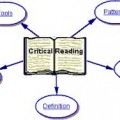
The Common Core notes one of the major key shifts in its standards: that students have experience in “regular practice with complex texts and their academic language” (from www.corestandards.org/key-shifts-in-english-language-arts/).
Of course, simply having students read complex materials without scaffolding or instruction are less likely to yield positive results than if you assist students in ways that will help them increase their comprehension and confidence. And although students vary widely in reading abilities – with some on grade level, others above, and others well below – there are some general strategies that can help students get more comfortable with this type of reading.
In “PARCC Resources: A Guide for Teachers and Parents” (PARCC Resources: A Guide for Teachers and Parents – by Julie C. Lyons), I mentioned Close Reading as one way to prepare your students for the PARCC. Today, let’s take a more in-depth look at (1) what Close Reading is; and (2) considerations for Close Reading in the classroom.
What is Close Reading?
According to Sheila Brown and Lee Kappes (Implementing the Common Core State Standards: A Primer on “Close Reading”, 2012), Close Reading is defined as:
“an investigation of a short piece of text, with multiple readings done over multiple instructional lessons. Through text-based questions and discussion, students are guided to deeply analyze and appreciate various aspects of the text, such as key vocabulary and how its meaning is shaped by context; attention to form, tone, imagery and/or rhetorical devices; the significance of word choice and syntax; and the discovery of different levels of meaning as passages are read multiple times” (Brown and Kappes, p. 2).
Considerations for Close Reading in the Classroom

In order to assist students with Close Reading, then, the teacher must first select a “brief, high-quality, complex text” (Brown and Kappes, p.3). The idea behind brevity is that students can reread and contemplate the central idea (and supporting details) more quickly and easily if the text is relatively short.
Next, students will read the text and discuss (or sometimes write about) what they have read. Depending upon reading levels, some students may need guidance and support at first, but the eventual goal is that the student can read the text independently and employ the Close Reading strategies successfully.
PARCC Test Practice: Online Resources for Educators
According to Brown and Kappes, the teacher’s role in Close Reading is to determine what background knowledge students may need to be able to successfully access the text; but this does not mean that the teacher is walking the student through the text. Rather, the teacher ensures that the children have the schema needed to be able to work with the text – even if it is a challenge and requires some perseverance. For this reason, thoughtful text selection is of paramount importance.
(To read the full report on Close Reading, see www.aspendrl.org/documentId.)
What if My Students Don’t Possess the Background Knowledge?
At this point, you may be asking, “How can I expect my students to succeed with complex texts when there are significant gaps in their background knowledge?” One way to address this is through read-alouds. In Core Instructional Routines (2014), Judy Dodge and Andrea Honigsfeld suggest that teachers “conduct frequent read-alouds and model our thinking for students. This builds students’ background knowledge about how to approach and deconstruct a text and how to make sense of what they are reading” (p. 13).
For this reason, consider locating texts related to what your students are about to read and then read that information (or excerpt from literature, depending upon the task) prior to asking students to read a new, difficult passage on their own. By providing them with the prerequisite information, they will approach the challenging text with more background knowledge, allowing them to better comprehend and access the reading selection. And for students who still struggle with the material, you may consider reading aloud to them as an initial scaffold until you can gradually release them to reading independently.
Conducting think-alouds is another way to help your students build the skills that good readers employ. By giving children a glimpse into your own thought processes, the insights and observations that you share as you “think aloud” provide children with a model for how to approach a text – especially when that text is challenging.
Once you model your thinking, you may wish to formalize certain strategies and post them on anchor charts for your students to frequently refer to. Moreover, you can ask students to share their own thinking with you during individual reading conferences (to ensure that they are applying the strategies and tips in their own reading).
Finally, the authors of Best Practices: Today’s Standards for Teaching and Learning in America’s Schools (2005) note that “veteran readers often have ways of marking or coding text they want to remember. Maybe they use a yellow highlighter, underline or box words, or put marks in the margins to flag questions, exclamation, or wonderment” (Zemelman and Daniels et. al, p. 235). By sharing how to mark the text as they do a Close Reading, you are teaching students a valuable skill that they can use on their own as well.
Final Thoughts

Yes, the Common Core’s emphasis on introducing students to texts that may be well above their instructional reading levels can make the task daunting to the classroom teacher, especially for his or her readers who struggle the most. And knowing that a student may become frustrated with the gap between his or her ability and the demands of the reading task are certainly valid concerns. It is for this reason that we as teachers must continue to establish the necessary scaffolds so that our children don’t become so discouraged that they give up.
By adding Close Reading to your existing repertoire of reading strategies, you will give your students the tools and confidence they will need to access challenging texts. And with time, perseverance, and sensitivity, it is quite possible to build self-efficacy in your students that leads to pride in their ability to tackle difficult reading material independently and with accuracy.






Pingback: SMARTER BALANCED SAMPLE QUESTIONS: ELA, GRADES 3-5
Pingback: Smarter Balanced Sample Questions: ELA, Grades 3-5 – by Julie C. Lyons | Lumos Learning
Pingback: How to Help Students With Increasingly Complex Text | Think Educative
Pingback: NJ ASK 2014 Results … And How To Use Them – by Julie C. Lyons | Lumos Learning
According to Brown and Kappes, the teacher’s role in Close Reading is to determine what background knowledge students may need to be able to successfully access the text; but this does not mean that the teacher is walking the student through the text. Rather, the teacher ensures that the children have the schema needed to be able to work with the text – even if it is a challenge and requires some perseverance. For this reason, thoughtful text selection is of paramount importance.
(To read the full report on Close Reading, see http://www.aspendrl.org/documentId.)
What if My Students Don’t Possess the Background Knowledge?
At this point, you may be asking, “How can I expect my students to succeed with complex texts when there are significant gaps in their background knowledge?” One way to address this is through read-alouds. In Core Instructional Routines (2014), Judy Dodge and Andrea Honigsfeld suggest that teachers “conduct frequent read-alouds and model our thinking for students. This builds students’ background knowledge about how to approach and deconstruct a text and how to make sense of what they are reading” (p. 13).
For this reason, consider locating texts related to what your students are about to read and then read that inform
Pingback: How to Help Students With Increasingly Complex ...